NTP基础培训资料
- 格式:ppt
- 大小:3.91 MB
- 文档页数:24
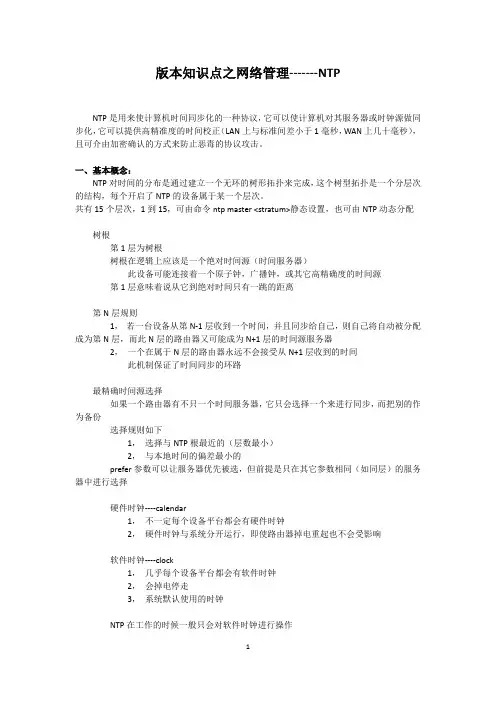
版本知识点之网络管理-------NTPNTP是用来使计算机时间同步化的一种协议,它可以使计算机对其服务器或时钟源做同步化,它可以提供高精准度的时间校正(LAN上与标准间差小于1毫秒,WAN上几十毫秒),且可介由加密确认的方式来防止恶毒的协议攻击。
一、基本概念:NTP对时间的分布是通过建立一个无环的树形拓扑来完成,这个树型拓扑是一个分层次的结构,每个开启了NTP的设备属于某一个层次。
共有15个层次,1到15,可由命令ntp master <stratum>静态设置,也可由NTP动态分配树根第1层为树根树根在逻辑上应该是一个绝对时间源(时间服务器)此设备可能连接着一个原子钟,广播钟,或其它高精确度的时间源第1层意味着说从它到绝对时间只有一跳的距离第N层规则1,若一台设备从第N-1层收到一个时间,并且同步给自己,则自己将自动被分配成为第N层,而此N层的路由器又可能成为N+1层的时间源服务器仅供学习参考,请勿用于商业活动~ 2,一个在属于N层的路由器永远不会接受从N+1层收到的时间此机制保证了时间同步的环路最精确时间源选择如果一个路由器有不只一个时间服务器,它只会选择一个来进行同步,而把别的作为备份选择规则如下1,选择与NTP根最近的(层数最小)2,与本地时间的偏差最小的prefer参数可以让服务器优先被选,但前提是只在其它参数相同(如同层)的服务器中进行选择硬件时钟----calendar1,不一定每个设备平台都会有硬件时钟2,硬件时钟与系统分开运行,即使路由器掉电重起也不会受影响软件时钟----clock1,几乎每个设备平台都会有软件时钟2,会掉电停走3,系统默认使用的时钟NTP在工作的时候一般只会对软件时钟进行操作比如将同步到的时间写到软件时钟中去而硬件时钟的功能需要单独开启配置:clock calendar-valid开启硬件时钟,之后会将此硬件时钟作为权威时钟。
使用此命令需注意:1,最好只在没有提供更精准的时间的时候使用,因为硬件时钟虽然不掉电不停针,但时间也并非特别精准2,若使用了NTP又开启了硬件时钟,应该将同步到的NTP时间更新到硬件时钟中去3,NTP的服务器最好开启此功能同步命令:命令:clock update-calendar一次性的将软件时钟同步给硬件时钟。
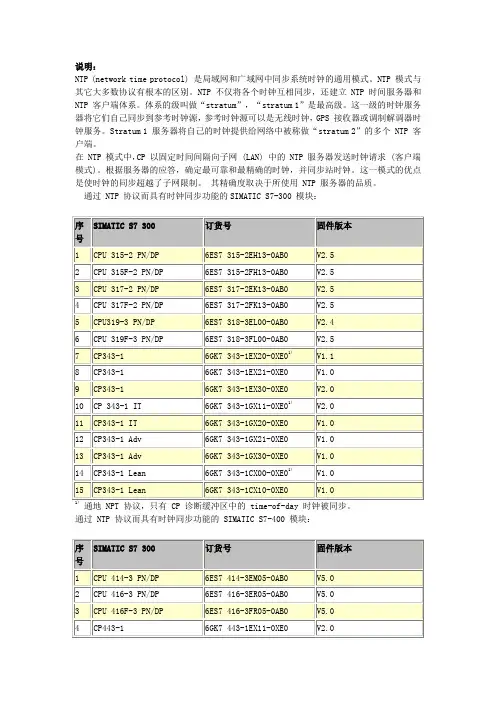
说明:NTP (network time protocol) 是局域网和广域网中同步系统时钟的通用模式。
NTP 模式与其它大多数协议有根本的区别。
NTP 不仅将各个时钟互相同步,还建立 NTP 时间服务器和NTP 客户端体系。
体系的级叫做“stratum”,“stratum 1”是最高级。
这一级的时钟服务器将它们自己同步到参考时钟源,参考时钟源可以是无线时钟,GPS 接收器或调制解调器时钟服务。
Stratum 1 服务器将自己的时钟提供给网络中被称做“stratum 2”的多个 NTP 客户端。
在 NTP 模式中,CP 以固定时间间隔向子网 (LAN) 中的 NTP 服务器发送时钟请求 (客户端模式)。
根据服务器的应答,确定最可靠和最精确的时钟,并同步站时钟。
这一模式的优点是使时钟的同步超越了子网限制。
其精确度取决于所使用 NTP 服务器的品质。
通过 NTP 协议而具有时钟同步功能的SIMATIC S7-300 模块:通地 NPT 协议,只有 CP 诊断缓冲区中的 time-of-day 时钟被同步。
通过 NTP 协议而具有时钟同步功能的 SIMATIC S7-400 模块:CPU 通过 NTP 协议进行时钟同步在 STEP 7 的硬件组态中设置。
为此,打开 PN-IO 接口的属性,选择时钟同步标签。
勾选“Activate NTP time-of-day synchronization” (“激活 NTP 时钟同步”)。
在 (“NTP 服务器地址”) 区输入相应的 NTP 服务器。
重要事项:NTP 模式不支持夏令时和冬令时之间的自动转换。
协议中未提供此服务。
如何计算夏令时时间在条目:19324378中描述。
在 S7300 和 S7400 CPU 中使用 NTP 时钟同步模式时不能设置任何时区。
CP 343-1 IT 6GK7343-1GX20-0XE0:当使用“Set CPU time”时,必须为 CPU 选择 MPI 地址 2 。
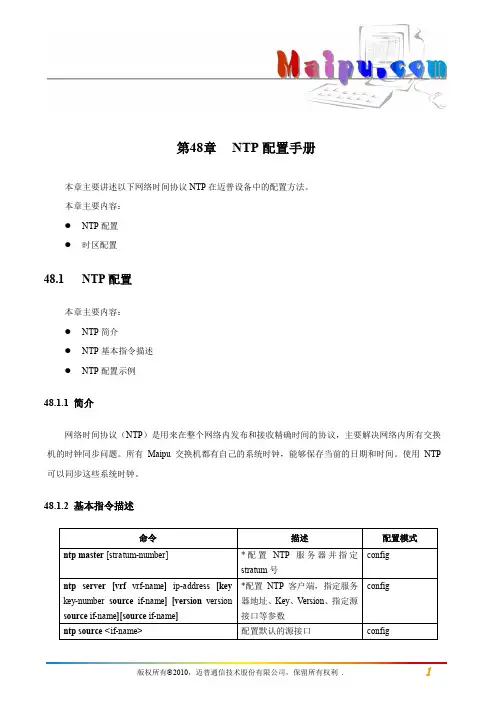
第48章NTP配置手册本章主要讲述以下网络时间协议NTP在迈普设备中的配置方法。
本章主要内容:●NTP配置●时区配置48.1 NTP配置本章主要内容:●NTP简介●NTP基本指令描述●NTP配置示例48.1.1简介网络时间协议(NTP)是用来在整个网络内发布和接收精确时间的协议,主要解决网络内所有交换机的时钟同步问题。
所有Maipu交换机都有自己的系统时钟,能够保存当前的日期和时间。
使用NTP 可以同步这些系统时钟。
48.1.2基本指令描述注:命令描述前带“*”符号的表示该命令有配置实例详细说明。
⏹ntp master启动NTP服务器;否则使用no格式。
ntp master stratum-numberno ntp master语法描述stratum-number 配置服务器stratum值,范围2-15默认为8 【缺省情况】未定义。
⏹ntp server配置NTP客户端,指定服务器的IP地址,使用no命令删除服务器ntp server [vrf vrf-name] ip-address key key-number version version source if-nameno ntp server [vrf vrf-name] ip-address语法描述vrf vrf-name NTP工作的VRFip-address NTP服务器地址key key-number指定认证服务器密钥,范围1-4294967295version version指定NTP工作版本号,范围1-4默认4source if_name指定NTP发送时的源源接口即源IP地址【缺省情况】未定义⏹ntp authenticate使能客户端的认证功能,no命令关闭。
ntp authenticateno ntp authenticate【缺省情况】未定义⏹ntp authentication-key配置NTP认证密钥,no命令删除。

一、概述随着科学技术与国民经济的发展,各行各业对标准时间的需求也日益增长,尤其在电力、金融、通信、交通、广电、安防、石化、冶金、水利、国防、医疗、教育、政府机关、IT等领域更加突出。
在“时间就是金钱”的时代,保证时间的正确性是一项十分重要的基础工作。
由济南唯尚电子有限公司独立研制生产的NTP网络时间校时模块是一款基于NTP/SNTP协议的高品质时间服务器产品。
该模块从GPS上获取标准时间信息,通过NTP/SNTP协议同步网络中的所有计算机、控制器等设备,实现网络授时,因其具有对时精度高,传输距离不受限制等特点,目前已在诸多行业得到广泛应用。
在当今飞速发展的网络时代,网络数据文件的读取和存贮,网上的结、付账系统,电子商务系统,网上B2B系统,数据库的保存及维护以及许多必不可少的网络应用都无法离开高精度的网络时间校时模块,它结合高速大容量的网络接口,并基于互联网的用户接口,支持多种网络协议,对造就真正的时间同步网络具有非常重大的意义。
该产品是真正意义上的NTP网络时间服务器,在技术上处于国内领先水平,已达到国外同类产品的技术水平。
而国内大多厂家提供的网络对时接口采用SNTP协议或将串口转换成RJ45接口,此方式根本无法保证对时的准确性,而且针对不同的操作系统需要开发相应的对时软件才能实现网络对时,从而使对时系统有相当大的局限性和不准确性,并不能满足真正意义的网络对时。
二、系统工作原理网络时间校时模块需配置在W系列同步时钟内使用,同步时钟将标准的时间信息通过RS-232接口向网络时间校时模块提供时间信息和秒脉冲信号,该时间同步信号同步于世界时UTC。
NTP服务器软件使模块成为标准NTP网络时间服务器,并能通过客户端软件同步网内的WINDOWS9X/NT工作站,而WINDOWS 2000/XP/2003、LINUX、UNIX、SUN SOLARIS等操作系统及CISCO的路由器、交换机则可通过自带的NTP/SNTP客户端软件自动和网络时间服务器对时,从而实现网络授时功能。
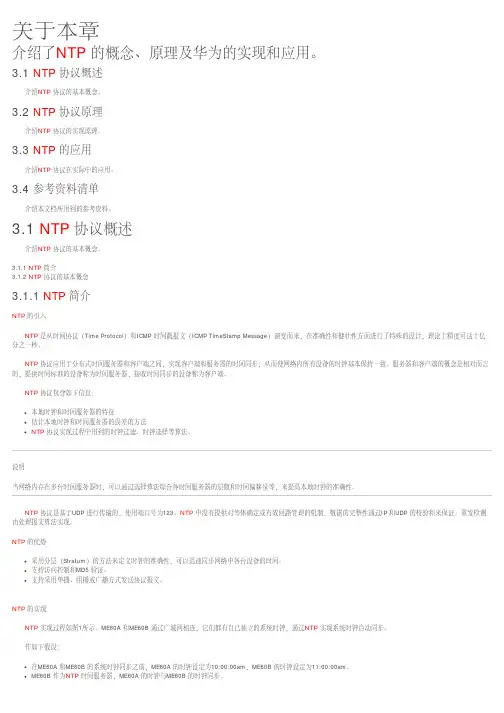
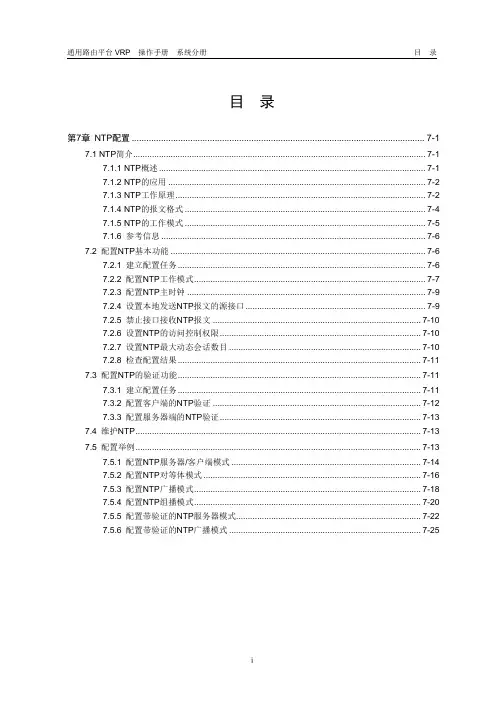
目录第7章NTP配置..................................................................................................................7-17.1 NTP简介 .................................................................................................................. 7-17.1.1 NTP概述......................................................................................................... 7-17.1.2 NTP的应用 ..................................................................................................... 7-27.1.3 NTP工作原理.................................................................................................. 7-27.1.4 NTP的报文格式............................................................................................... 7-47.1.5 NTP的工作模式............................................................................................... 7-57.1.6 参考信息......................................................................................................... 7-67.2 配置NTP基本功能 ................................................................................................... 7-67.2.1 建立配置任务.................................................................................................. 7-67.2.2 配置NTP工作模式.......................................................................................... 7-77.2.3 配置NTP主时钟............................................................................................. 7-97.2.4 设置本地发送NTP报文的源接口...................................................................... 7-97.2.5 禁止接口接收NTP报文................................................................................. 7-107.2.6 设置NTP的访问控制权限.............................................................................. 7-107.2.7 设置NTP最大动态会话数目 .......................................................................... 7-107.2.8 检查配置结果................................................................................................ 7-117.3 配置NTP的验证功能.............................................................................................. 7-117.3.1 建立配置任务................................................................................................ 7-117.3.2 配置客户端的NTP验证................................................................................. 7-127.3.3 配置服务器端的NTP验证.............................................................................. 7-127.4 维护NTP................................................................................................................ 7-137.5 配置举例 ................................................................................................................ 7-137.5.1 配置NTP服务器/客户端模式 ......................................................................... 7-137.5.2 配置NTP对等体模式 .................................................................................... 7-167.5.3 配置NTP广播模式........................................................................................ 7-187.5.4 配置NTP组播模式........................................................................................ 7-207.5.5 配置带验证的NTP服务器模式....................................................................... 7-227.5.6 配置带验证的NTP广播模式 .......................................................................... 7-24第7章 NTP配置网络时间协议NTP(Network Time Protocol)属于应用层协议,用来在分布式时间服务器和客户端之间进行时间同步。

关于NTP1. NTP概念简介Network Time Protocol(NTP)是用来使计算机时间同步化的一种协议,它可以使计算机对其服务器或时钟源(如石英钟,GPS等等)做同步化,它可以提供高精准度的时间校正(LAN上与标准间差小于1毫秒,W AN上几十毫秒),且可由加密确认的方式来防止恶毒的协议攻击。
2.NTP如何工作NTP提供准确时间,首先要有准确的时间来源,这一时间应该是国际标准时间UTC。
NTP获得UTC的时间来源可以是原子钟、天文台、卫星,也可以从Internet上获取。
这样就有了准确而可靠的时间源。
时间按NTP服务器的等级传播。
按照离外部UTC 源的远近将所有服务器归入不同的Stratun(层)中。
Stratum-1在顶层,有外部UTC接入,而Stratum-2则从Stratum-1获取时间,Stratum-3从Stratum-2获取时间,以此类推,但Stratum层的总数限制在15以内。
所有这些服务器在逻辑上形成阶梯式的架构相互连接,而Stratum-1的时间服务器是整个系统的基础。
计算机主机一般同多个时间服务器连接,利用统计学的算法过滤来自不同服务器的时间,以选择最佳的路径和来源来校正主机时间。
即使主机在长时间无法与某一时间服务器相联系的情况下,NTP服务依然有效运转。
为防止对时间服务器的恶意破坏,NTP使用了识别(Authentication)机制,检查来对时的信息是否是真正来自所宣称的服务器并检查资料的返回路径,以提供对抗干扰的保护机制。
3.网络校时协议(NTP)的实现时间服务器可以利用以下三种方式与其他服务器对时:broadcast/multicast、client/server、symmetricbroadcast/multicast方式主要适用于局域网的环境,时间服务器周期性的以广播的方式,将时间信息传送给其他网路中的时间服务器,其时间仅会有少许的延迟,而且配置非常的简单。


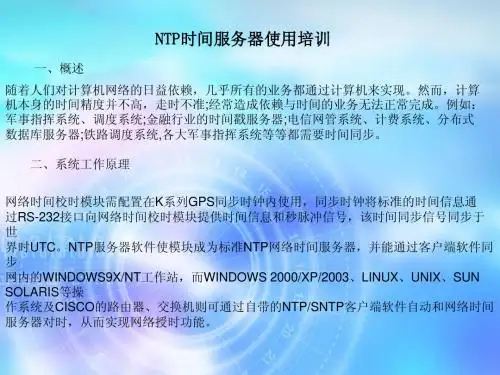
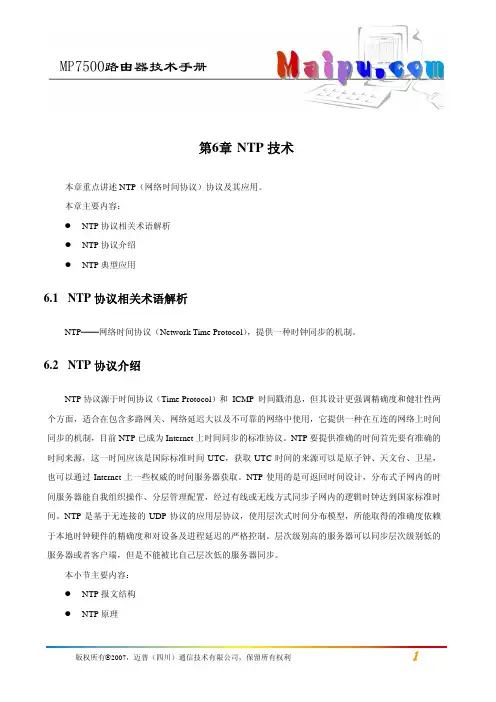
第6章 NTP技术本章重点讲述NTP(网络时间协议)协议及其应用。
本章主要内容:z NTP协议相关术语解析z NTP协议介绍z NTP典型应用6.1NTP协议相关术语解析NTP——网络时间协议(Network Time Protocol),提供一种时钟同步的机制。
6.2NTP协议介绍NTP协议源于时间协议(Time Protocol)和 ICMP 时间戳消息,但其设计更强调精确度和健壮性两个方面,适合在包含多路网关、网络延迟大以及不可靠的网络中使用,它提供一种在互连的网络上时间同步的机制,目前NTP已成为Internet上时间同步的标准协议。
NTP要提供准确的时间首先要有准确的时间来源,这一时间应该是国际标准时间UTC,获取UTC时间的来源可以是原子钟、天文台、卫星,也可以通过Internet上一些权威的时间服务器获取。
NTP使用的是可返回时间设计,分布式子网内的时间服务器能自我组织操作、分层管理配置,经过有线或无线方式同步子网内的逻辑时钟达到国家标准时间。
NTP是基于无连接的UDP协议的应用层协议,使用层次式时间分布模型,所能取得的准确度依赖于本地时钟硬件的精确度和对设备及进程延迟的严格控制。
层次级别高的服务器可以同步层次级别低的服务器或者客户端,但是不能被比自己层次低的服务器同步。
本小节主要内容:z NTP报文结构z NTP原理z NTP 的工作模式6.2.1 NTP 报文结构NTP 协议是建立在UDP 协议之上的应用层协议,使用的UDP 端口号是123。
NTP 报文结构如下: LI (2bits ) VN (3bits ) Mode (3bits )Stratum(8bits ) Poll (8bits )Precision (8bits ) Root Delay (32bits )Root Dispersion (32bits )Reference Identifier (32bits )Reference Timestamp (64bits)Originate Timestamp (64bits)Receive Timestamp (64bits)Transmit Timestamp (64bits)Key Identifier (32bits )(optional )Message Digest (128bits) (optional)LI 闰秒标识器VN 版本号Mode 模式Mode含 义 0保留 1主动对称模式 2被动对称模式 3客户模式 4服务器模式 5广播模式 6为NTP 控制信息保留 7 为自用保留Stratum 层,表示时钟所处的层次级别,取值范围一般为1-15,值越小层次越高。
目录1.NTP概述 2 1.1 NTP时间同步原理 2 1.2 NTP分层构建原理 3 2.M2000时间同步目的 4 3.时间同步简介 4 4.M2000系统时间同步方式 5 4.1 M2000-NTP设置类型 5 4.2 M2000服务器Solaris系统的中间级NTP服务器设置 5 4.2.1 查看服务器系统时间 5 4.2.2 设置M2000管理控制台为中间级NTP服务器 5 4.3 客户端NTP配置 8 4.3.1 修改客户端注册表 8 4.3.2 在CMD命令下修改 9 5.网元设备时间同步方式 9 6.设置cisco3662为2级NTP106.1 命令定义:106.2 配置实例10NTP服务器调测总结概述介绍NTP(Network Time Protocol)和SNTP(Simple Network Time Protocol)的时间同步原理和分层构建原理。
NTP时间同步原理NTP用于在分布式时间服务器和客户端之间进行时间同步,它定义了时间同步实现过程中所使用的结构、算法、实体和协议。
NTP协议基于TCP/IP中的IP和UDP 协议栈,也可以被其它协议组使用。
从理论上讲,精度可达到十亿分之一秒。
NTP的时间同步基本原理如图1所示。
图1 NTP基本原理图设备A和设备B通过网络相连,它们都有自己独立的系统时间,要实现各自系统时钟的自动同步,作如下假设:在设备A和B的系统时间同步之前,设备A的时钟设定为10:00:00,设备B的时钟设定为11:00:00。
以设备B为NTP时间服务器,即设备A将使自己的时间与设备B的时间同步。
数据包在设备A和B之间单向传输所需要的时间为1秒。
设备A如果要从设备B同步时间,至少应知道两个信息,即:A与B之间的时间差为多少,可称为offset。
A与B同步过程中,在路途上的损耗,可称为delay。
获得这两个消息,A即可顺利计算出如果要同步到B,应修改多少时间量。
NTP原理解析什么是NTP?网络时间协议(Network Time Protocol,简称NTP)是一种用于同步计算机系统时钟的协议。
它通过网络传输时间信息,使得计算机在不同的地点能够保持高度准确的时间同步。
NTP广泛应用于互联网、局域网和广域网等各种网络环境中。
NTP的基本原理NTP的基本原理可以分为两个主要部分:时钟同步和时钟校准。
下面将详细介绍这两个部分。
1. 时钟同步在计算机系统中,每台计算机都有一个本地时钟,用于记录当前时间。
然而,由于硬件和软件的差异以及外界环境因素的干扰,每台计算机的本地时钟并不准确。
为了实现时钟同步,NTP引入了一个主从模型。
•主节点(或称为服务器):主节点拥有一个高精度的参考时钟,通常是由GPS等外部设备提供的。
它负责向从节点提供准确的时间信息。
•从节点(或称为客户端):从节点通过与主节点进行通信来获取准确的时间信息,并校正自己的本地时钟。
主节点和从节点之间通过网络进行通信。
NTP中的主要概念是”stratum”,它表示从节点与参考时钟之间的层级关系。
主节点具有较低的stratum值,而从节点则具有较高的stratum值。
NTP协议中定义了一种称为”网络时间传输协议(Network Time Transfer Protocol,简称NTTP)“的子协议,用于在主节点和从节点之间传输时间信息。
通过NTTP,主节点将自己的时间信息以及其他相关数据传输给从节点。
时钟同步过程如下:1.从节点向主节点发送一个请求,请求获取准确的时间信息。
2.主节点接收到请求后,将当前时间和其他相关数据打包发送给从节点。
3.从节点接收到响应后,解析数据包并根据主节点提供的时间信息来校正自己的本地时钟。
为了提高精度和可靠性,NTP采用了一些技术手段:•多个主节点:一个从节点可以同时连接多个主节点,并根据多个来源的时间信息进行校正。
这样可以提高准确性和容错能力。
•冗余路径:NTP允许在网络中存在多条路径连接各个主从节点。
NTP讲义Introduction to Network Time Protocol2002/12/18雷振1.Content●basic concepts of NTP●Implementing and configuration●Managing, and troubleshooting2.References●RFC-1305●Using NTP to Control and Synchronize System Clocks(SunBluePrints?)●Xntpd Man page3.Basic concepts of NTP3.1.What is NTP?●Control and Synchronize System Clocks among a set of distributedtime servers and clients●The standard of RFC13053.2.Why NTP?●Inaccurate time: Electronic clocks in most servers and networkingdevices keep inaccurate time.●The Need for Synchronized time: Every aspect of managing,securing, planning, and debugging a network involves determining when events happen./doc/618e842f453610661ed9f4ab.html mon UNIX Commands Related to Time3.4.Other time protocols●DTS or DTSS: Digital Time Service(for LAN evniroment)●SNTP: Simple Network Time Protocol, is a lightweight variation ofNTP, Wintel platform3.5.NTP principles●not based on the principles of synchronizing machines clock witheach other.●based on the principles of having all machines get as close as possibleto the correct time, even in the presence of incorrect time sources, or when accurate time sources are temporarily unavailable3.6.NTP Strata●NTP works on a hierarchical model●Clients can use time information from multiple servers toautomatically determine the best source of time3.7.How to judge the accuracy of clocks●how “close” a clock is to a reference clock—Stratum●the network latency to the clock—delay●the claimed accuracy of the clock—dispersion3.8.NTP accuracy●The maximum resolution of an NTP time stamp is about 200picoseconds(10 -12)●Ultimate accuracy of NTP is limited by hardware and latency, ratherthan by the NTP protocol.●Some environments accuracyLAN: within a few milliseconds is normal.WAN: within the range of 10-100 ms.Internet: unpredictable3.9.The ultimate source of NTP time●Coordinated Universal Time(UTC),●UTC evolved from Greenwich Mean Time (GMT)●UTC is synchronized according to time zone3.10.N TP uses the UDP protocol on port 123 to communicate between clients and servers.3.11.T ypes of Clients and Servers●Non-broadcast mode(LAN/WAN)ServerClient●Broadcast mode(LAN)Broadcast/multicast serverBroadcast/multicast client●Peer mode(same stratum)3.12.N TP Algorithms●Choose the best source from among several possible sources.(server) based on several factors, including:the offsetthe delayan error factor.●How NTP client adjusts the local clockSlewing: gradual adjustmentStepping: instant adjustment3.13.T erms●Offset: half the difference between the time it takes for theclient/server query and the server/client response.●delay:round-trip time for the client query to be received back by the client, the time the server spends processing the client query is subtracted●error factor: represents errors related to clock reading times and frequency tolerance●Dispersion: represented as half the delay plus the error●Synchronization distance: dispersion plus one-half the absolute delay●IllustrationThe offset is ((B-A)-(D-C))/2, or .005 seconds.The delay is ((D-A)-(C-B)), or .03 seconds.3.14.R esource Requirements●NTP requires little resource overhead.● A broadcast server sends out a packet about every 64 seconds.● A non-broadcast client/server requires 2 packets per transaction. When first started, transactions occur about once per minute, increasing gradually to once per 17 minutes under normal conditions.3.15.N TP components●Xntpd: NTP daemon, used both for client and server and started automatically on OS startup●/etc/inet/ntp.conf: config file which configures the NTP servers and clients. If the file exists, NTP daemon start, otherwise, not.●ntpdate: fast initial synchronization before using xntpd,●ntpq: querying the state of the NTP daemon on a local or remote machine.●Xntpdc: querying the state of a local or remote NTP daemon, and making runtime configuration requests to a remote machine.●Ntptrace: trace a chain of NTP hosts back to their master time source3.16.S olaris NTP Versions4.Implementing and configuration (server/client/peer) 4.1.NTP server (stratum 0) setup4.1.1.create /etc/inet/ntp.conf file################################server 127.127.1.0 preferfudge 127.127.1.0 stratum 0driftfile /var/ntp/ntp.driftstatsdir /var/ntp/ntpstats/filegen peerstats file peerstats type day enablefilegen loopstats file loopstats type day enablefilegen clockstats file clockstats type day enable################################4.1.2.Edit /etc/rc2.d/S74xntpdadd /usr/lib/inet/xntpd -l /var/ntp/ntp.log4.1.3.Start xntpd daemon/etc/rc2.d/S74xntpd start4.1.4.Verify the server setup# ntpq -premote refid st t when poll reach delay offset disp ===================================================== *LOCAL(0) .LCL. 0 l 51 64 377 0.00 .000 10.03 4.2.NTP Client/Peer Setup4.2.1. create /etc/inet/ntp.conf fileserver 192.168.2.202 #### ip address of statum 1 serverpeer 192.168.2.204 #### ip address of peer statum 2 server driftfile /var/ntp/ntp.driftstatsdir /var/ntp/ntpstats/filegen peerstats file peerstats type day enablefilegen loopstats file loopstats type day enablefilegen clockstats file clockstats type day enable4.2.2.Edit /etc/rc2.d/S74xntpdadd /usr/lib/inet/xntpd -l /var/ntp/ntp.log4.2.3.Start xntpd daemon/etc/rc2.d/S74xntpd start4.2.4.check to see if it is bound to a NTP server or not.# ntpq -premote refid st t when poll reach delay offset disp====================================================*192.168.2.202 .LCL. 1 u 591 1024 377 0.66 0.086 0.14+192.168.2.204 192.168.2.202 2 u 60 64 376 0.41 -0.077 0.524.3.Modify ntp.conf●Modify /etc/inet/ntp.conf●Stop xntpd: /etc/rc2.d/S74xntpd stop●Restart xntpd: /etc/rc2.d/S74xntpd start●Check with ntpq -d4.4.Notice●Use date, rdate or ntpdate to modify local date●Use /etc/rc2.d/S74xntpd●About 5 minutes for client to reach synchronization●Each client uses numbers of independent servers●NTP allows a server to lose connectivity for up to 24 hours and still provide NTP service to its clients.●The calculated round trip delay and dispersion for server must be less than 16 seconds.●The total delay and maximum error must be less than 16 seconds from the root clock.●An NTP client can have a relationship with up to 64 servers, but only10 of these can serve as potential synchronization sources.●4.5.Other issues●ACL●Authentication●Broadcase/multicast configuration5.Managing, and troubleshooting5.1.log information●/var/adm/messages●command line option/usr/lib/inet/xntpd -l /etc/inet/ntp.log●config filestatsdir /var/ntp/ntpstats/filegen peerstats file peerstats type day enablefilegen loopstats file loopstats type day enablefilegen clockstats file clockstats type day enable5.2.ntpdate●set the date and time by way of NTPoffset is more than 0.5 second: settimeofday()offset is less than 0.t second: adjtime()●# ntpdate server_name5.3.debug output of xntpd# /usr/lib/inet/xntpd -d5.4.ntptrace# ntptrace hostnametrace a chain of NTP hosts back to their master time source5.5.Ntpq●querying the state of the NTP daemon on a local or remote machine.●Command line arguments mode or interactive mode5.5.1.Peers: prints peers state●Fields explanation1 Each server for the current host is listed,2 lists the servers’ current time source.3 indicates the stratum of the server.4 indicates the mode of the server.(l,u,b,m)5 indicates the number of seconds since the given server was last reached6 indicates the polling interval for a given host in seconds.7 indicates the history of reachability. displayed in octal, 377, which indicates that the last 8 attempts were good. 8~10 estimated delay, offset, and dispersion in milliseconds..●Flags: indicate how xntpd is using the listed servera current synchronization source time“*” or “o”healthy peer servers“-”: symmetric passive“+”: symmetric active“.”: culled from the end of the candidate 10 servers listnot synchronized“x”: the servers clock is unsynchronized or set incorrectly. Space: discarded due to high stratum and/or failed sanity checks others“#”: servers in the configuration are too far away to be useful.“=”: means the remote server is being polled in client mode “^”: sever is broadcasting to this address“~”: the remote peer is sending broadcasts5.5.2.associations: lists the status of the servers.●Status fields explanation●c/s synchronization status: 96145.5.3.host: select host5.5.4.cooked; format output5.5.5.debug; turn query program debugging on5.5.6.clockvar: subcommand lists the type of clock used by a given server.。